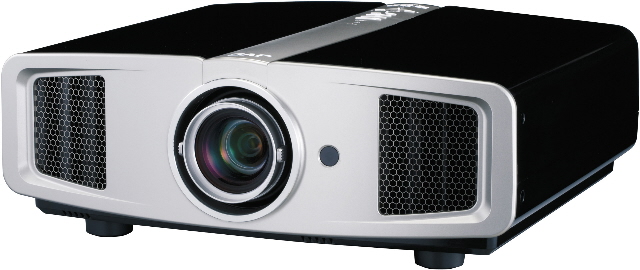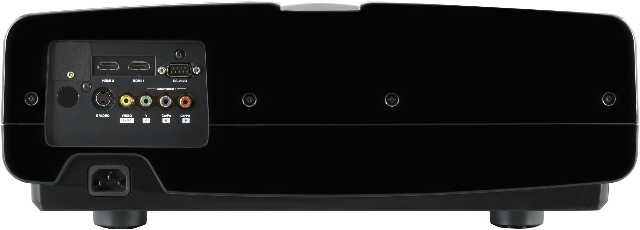Introduction
There was a lot of buzz after CEDIA and CES this past January. The
projector market has been going through a huge change over the last year and
the evolution of this market segment has been amazing to say the least. The
specs for projectors have improved rapidly and the prices have fallen nearly as
fast, and most of the buzz centers around the LCoS/SXRD market. Sony
re-invented the market with its 1080p "Ruby" SXRD, setting a new bar for what
could be afforded in the $10K projector arena.
In what seemed to be a one-two
combination they released the "Pearl", which had many of the same features you
found in the "Ruby" but without the Xenon bulb and nearly half the price. But
that wasn't the only buzz. JVC had shown some brief glimpses of a projector
that has had everyone really excited. This projector featured a new
design of their Liquid Crystal on Silicon (LCoS) technology that they've been
developing for some years now (and SXRD is rooted in) that greatly improved
response time and contrast ratio.
After hearing a flood of enthusiasm for this product
and glowing reviews from industry insiders and consumers alike, I finally
got my hands on one for review.
I've had lukewarm experience with JVC's
previous LCoS offerings. The HD-2K was quite popular and highly regarded
among aficionados, especially after a William Phelps tweaking, but I'd seen
variations of this projector from Faroudja and Meridian and while it looked
nice, it never sold me. Contrast wasn't what you could get from a lot of
other projectors out there at more attractive prices, and the image had a
harder edge to it than I would prefer, and these were "tweaked in" models.
The HD-1 is an entirely different beast, and it's easy to
see why it's become probably the most popular projector of its time. Looking
at the specs for this product, it is easy to see that this projector has a lot to offer
and would leave very few wanting. The HD-1 boasts a native contrast ratio of
15,000:1 with its new LCoS chip. This is a number that is almost unheard of in
the digital projection arena without the help of a dynamic iris. It also
features two HDMI inputs, Gennum video processing, a three-chip design for better
color reproduction, and a very flexible throw range combined with full
horizontal and vertical lens shift. The cherry on top is the price tag.
Normally a spec sheet like this would almost demand at least a mid-teens
figure, but I've seen this projector sold for less than $5K on the open market;
simply amazing.
The Design
JVC released two projectors that are nearly identical. There is a professional
model badged as the RS-1 and a consumer model badged as the HD-1. The only
difference we could find is the color of the chassis. The RS-1 is completely
black, while the HD-1 has a black case with silver trim. For this review, I
received the consumer model HD-1.

The HD-1 has a wide array of features. The projector is a
mid-weight unit as far as digital designs go. It is about average in size
but not as heavy as the reference Marantz projector I had been using at the
time. The case has an inlet vent on the right of the lens and an outlet on the
left side. JVC designed an air path to go around the lens assembly to help
keep noise down due to the fan. Fan noise is a big complaint from a lot of
projector owners, and some of the newer models out there have come a long way
in keeping noise down to an almost undetectable level. The HD-1 is pretty
quiet in Low Lamp mode. I barely noticed it even with my head a few feet away,
but it isn't the quietest design I've used to date. During quiet passages of
movies I could still detect it in the background just enough to know it was
on, but it was hardly intrusive.
Switching to High Lamp mode is another matter
though. The fan increases speed quite a bit, and the projector's noise is a bit
more objectionable. This wasn't a big deal to me, as I never required this much
light output, but it is something to consider if you're a consumer who needs
that kind of lumen output.
One of the handiest features of the HD-1 is its lens
shift capability. The design allows for vertical and horizontal movement
of the lens, a feature that can be quite handy during an installation. This is
handled via two dials beneath the lens. Overall, the feature worked as
advertised, but at times the knobs didn't seem to catch correctly and the lens
would shift more or less than expected. I've seen this same issue with just
about every projector I've used with this feature, but the flexibility makes up
for the cumbersomeness.
The zoom and focus of the lens are adjusted using levers
around the lens area. I wasn't that impressed with the operation of these
levers, and it was easy to affect one while dialing in the other. I also
thought that focus quality across the whole screen wasn't as good as some
other projectors I've used in the past, including my reference Marantz VP11S1.
The back panel has two HDMI inputs, a feature that I
always love to see on new projectors as it allows more flexibility when I'm
reviewing other products. You also get the standard component, S-Video, and
composite inputs.

The top of the projector has controls for power and menu
operation. These were easy enough to use, but since I mount projectors on my
ceiling, I rarely if ever operated them.
The New Look of LCoS
JVC
developed a completely new LCoS chip for this projector line. They improved
their native contrast to 20,000:1, but coupled with the polarizer for the three
chips and the lens assembly, they are achieving about 15,000:1 on the screen.
This is one of the only projectors we've ever seen that actually met or
exceeded its advertised contrast ratio. We measured as high as around 19,000:1
in some areas of the screen and down to around 12,000:1 in other areas. This
is actually one of my biggest complaints about this projector though.
Uniformity in black is just not that great.
Because of the lens assembly, JVC is not
able to have perfect uniformity across the screen. In this case, the corners
are a lot lighter than the center of the image. I actually looked at several
units during this review and the level of uniformity varied quite a bit from
unit to unit, with some having only a slight uniformity issue in the corners,
while others had it quite bad.
During
most viewing this wasn't much of an issue. I saw the problem on occasion,
but it was hardly distracting. I still feel that JVC needs to try and get a
handle on the issue though. We were seeing the same issues with the Sony SXRD
designs, and I think it would give any company a big leg up in this market
segment if they could eliminate the issue and deliver consistent contrast
across the screen.
Another
improvement was refresh rate. Previous LCoS designs had a bit of a "swimmy" look
to me. Trails weren't much of an issue, but most of the image had a smoothed
out look to it. That wasn't a problem with this unit. Image pans looked as
natural as the source would allow, and I was never distracted by a processed
look that too many digital displays have.
Go to Part II.